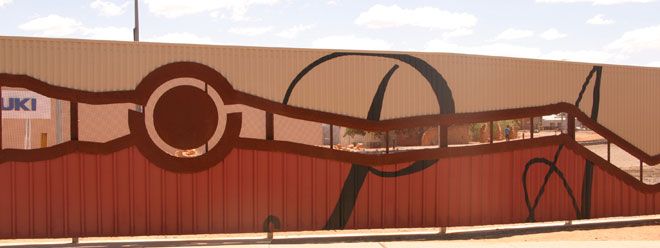Our woman-made environment
15 March 2012
By KIERAN FINNANE

An exhibition on the theme of women architects, town planners and landscape architects in Central Australia ran the risk of being a little thin, feared Anne Scherer when she voluntarily took on the task to mark Australian Women’s History Month – March, of course – at the National Pioneer Women’s Hall of Fame.
The theme is set nationally by the Australian Women’s History Forum. Ms Scherer was well aware of architect Susan Dugdale, whose imprint can be seen in many corners of Alice Springs, but who else? She uncovered quite a diverse history, including the existence of Helen Tippett, likely to have been the first female architect to practice in town, back in the 1950s, after completing her training in Melbourne. She was interested in the concept of ‘sustainable housing’ long before it was fashionable, went on to practice in the Middle East and to have an illustrious academic career in New Zealand.
Ms Scherer’s research, attractively presented in the women’s cell block of the old gaol that houses the Hall of Fame, reminds us of other women who have left their mark on the built environment of Alice Springs, broadening the terms of the exhibition to include artists such as Cedar Prest, who executed the stained glass window at Araluen after a design by W. Rubuntja; Kaye Kessing, who with Bob Kessing painted the Coles supermarket mural facing Railway Terrace; Pip McManus, who has contributed ceramic and sculptural work to some of our major institutions; Sally Mumford whose 2008 exhibition This Place was a thoughtful reflection on the changes wrought over time on the place, Mparntwe, and the town, Alice Springs.
She has noted the contribution of the women who worked in the early hotels, taking them from rough bush pubs to more hospitable places, and of women like Sister Jean Finlayson who had input to the design of Adelaide House and in the present, Sarah Brown, who has driven the “adaptive re-use” of a suburban house, The Purple House, to provide a dialysis clinic but also a home-like meeting place complete with bush medicine garden.
And of course along the way architects such as Deb Fisher (Raptor Building, Desert Park) and Jane Dillon (Congress Medical Centre) are honoured.
Susan Dugdale, who arrived in Alice in 1994, establishing her own practice in 2000, was present at the opening on Sunday. She reflected on what had made her stay – it came down to job satisfaction, being able to make a contribution through her designs to people’s lives. She contrasted her last Melbourne job, which was working on a four bedroom house renovation for a couple whose children had left home, with the social purposefulness of many of the projects she has worked on here. The “Lolly Houses” for the Yuendumu Old Peoples Program (the name refers to the bright colours favoured by the residents), the Hospital Staff Units (next to the Hall of Fame), the refurbishment of the Yeperenye Shopping Centre (now 10 years old), and the Stuart Highway Fence are a few examples, all of them mindful of the environmental, historical and social context in which they stand.
This is a rewarding exhibition, reminding us of a whole range of rich contributions to, in this case, the woman-made environment of The Centre.
Pictured, left to right: Anne Scherer, Miriam Wallace, and Susan Dugdale. Ms Wallace works for Susan Dugdale and Associates. In the wall text dedicated to her, she sums up the lessons she’s learnt from Ms Dugdale: “how to design buildings appropriate to the place, both in scale, materials and methods of construction” and also “about the complexity of remote community work and client /contractor relationships”.
Below: Susan Dugdale’s Stuart Highway Fence, constructed in 2008.
.


